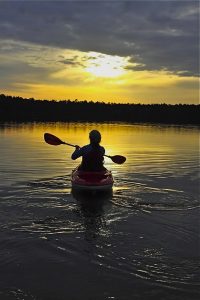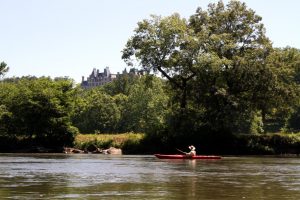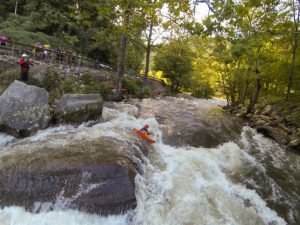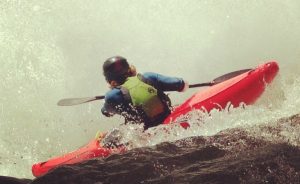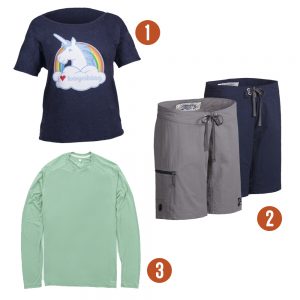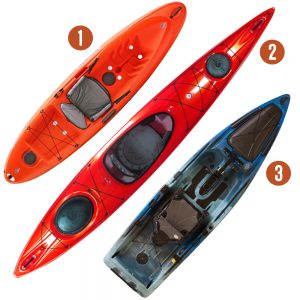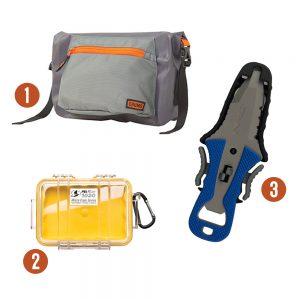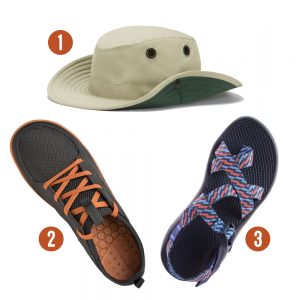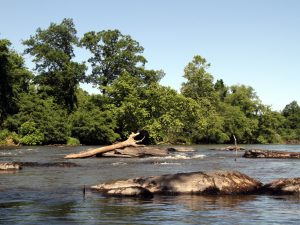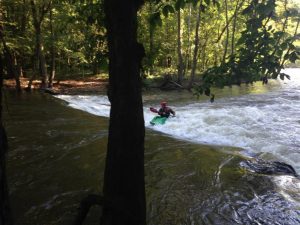With 38 inches of annual rainfall and dam released rivers that run throughout the year, the Asheville area in Western North Carolina is one of the top paddling destinations in the United States. The laid back Blue Ridge culture compliments the surreal beauty of the mountains and the remote gorges that the rivers have cut through them.
French Broad River

The most popular stretch of the French Broad is the 3.5-mile intermediate run between the Madison County put-in and the Stackhouse take-out. Although it won’t present much of a challenge to the expert paddler, the beauty and seclusion of this run makes it a favorite for whitewater enthusiasts across the board. Paddlers will enjoy an even distribution of splashy class II and III rapids with a few sequences and holes to keep it punchy. For a longer day, continue to the second take-out in Hot Springs and enjoy two larger rapids along the way: Frank Bell’s (IV) and Kayaker’s Ledge (III+).
After a heavy rain, expert kayakers can tackle the challenges of the North and West Forks of the French Broad River. These two creeks have a completely different temperament than the friendly features of Section 9. Although the North Fork is considered a class IV creek, it includes two class V rapids and some mean sieves. The West Fork is solid class V with bigger drops and bigger threats than its brother. A missed line on either of these creeks could have serious consequences. Be on the lookout for the additional dangers of errant wood and lumber.
The Green River

Melina Coogan
The scenic, dam-release Green River, which runs roughly 300 days out of the year, is considered the Holy Grail of whitewater in the Southeast. Three distinct sections of river offer a beautiful day of paddling for boaters of all abilities. The boulder congested Green River Narrows, a low volume, class V steep creek, serves as the main staple for advanced paddlers. Precise boat control is necessary to navigate the big slides, mandatory boofs, and tight rapids that plunge through a heavily forested gorge. Expert kayakers from across the country visit the Green to test themselves against The Big Three: Gorilla, Sunshine, and the sinisterly named Go Left or Die.
The Upper Green is an enjoyable 3.7-mile run of class III rapids. This ideal learning spot includes two challenging III+ drops: Bayless’ Boof and Pinball. The take out includes a brutal uphill hike, but for boaters who dream of one day running the Narrows, it’s well worth the cost. The mellow Lower Green is rippled with class I and II rapids for a fun and easy float. This stretch is perfect for beginners looking to log some river miles and nail their combat roll.
Big Laurel Creek
Tucked into a deep, wooded gorge, the class III/IV Big Laurel Creek provides an excellent introduction to creeking. Ambitious intermediate paddlers will love the forgiving nature and epic feel of this Appalachian gem. Dropping over 200 feet in 3.7 miles, the river offers up three major rapids linked together with tons of fun moves. The first big drop, Stairstep, is found one mile down the run and can be easily scouted on the trail on river left. Be wary of the next rapid, Suddy Hole, as the big, boxed-in hole on river right is the most dangerous feature on the run. Luckily, it can easily be avoided by a taking a clean line just right of center, off the river-wide ledge.
The run begins in Hurricane and concludes in Hot Springs, where it joins the French Broad River. From here, you can hike your boat upstream and take out at the Stackhouse or continue down the second portion of Section 9 on the French Broad. If you choose to continue, you will be faced with Windy Flats, a shallow, two mile stretch of flat water, before you’re rewarded with the two most challenging rapids of Section 9, Frank Bell’s, and Kayaker’s Ledge.
The Nolichucky Gorge

Melina Coogan
The Nolichucky River is a beautiful and playful intermediate run just over the border in Tennessee. Nearly 9 miles long, this all day adventure is perfect for a warm spring day, although when the sun drops below the gorge it can get cold fast, so pack accordingly.
You will be greeted with a series of splashy, straightforward class III rapids downstream of the railroad trestle at the put in. The first major drop, a bouncy chute known as On the Rocks, has a clean line straight down the tongue. After this, you will find a set of waves and a big, juicy hole called Jaws, one of the best play spots in the area. Make sure you’re aware of the water levels, as this normally friendly hole can get sticky above 2,000 CFS. Your next big drop will be Quarter Mile, by far the most dangerous of the river. This class IV rapid culminates in a nasty, recirculating pourover called Murphy’s Ledge. There is a solid eddy above the rapid and its entire length can be scouted from the train tracks. From here, the river mellows out with more fun class III and small waves, the perfect playground for anyone just learning to surf.
Pigeon River

Melina Coogan
The Pigeon River is the next step for the progressing kayaker after they have mastered Section 9 of the French Broad. This five mile run winds along the Eastern boundary of Great Smoky Mountain National Park. It is packed with big water class III-III+ rapids with names like Roller Coast, Accelerator, and Powerhouse. Pushy, bouncy waves make for a thrilling but not too threatening ride for intermediate paddlers. The single class IV rapid, Lost Guide, has a juicy hole that can be sneaked on the side. Play boaters will have their pick of features for surfing and wave wheals.
This river is dam released; the water is turned on from 11:30 am to 6pm. Because of its popularity and easy accessibility, you will probably find yourself surrounded by many others enjoying themselves in rafts and kayaks. This is a recent occurrence in the river’s history: for the majority of the 20th century, severely polluted from a paper mill, the Pigeon was declared biologically dead. It was even known to locals as The Dirty Bird. It wasn’t until the early-2000s, when fish, snails, and mussels were reintroduced to the waters, that the river came back to life. Soon after, paddlers flocked to this once abandoned river, although it is still threatened by contamination.
Featured image provided by Melina Coogan


